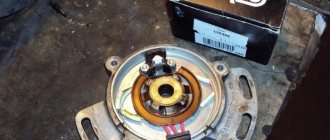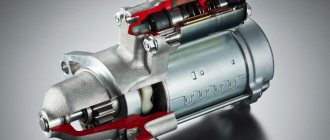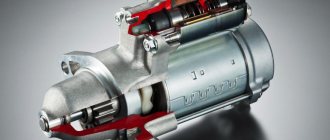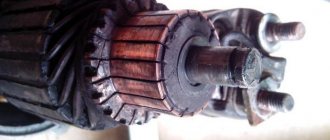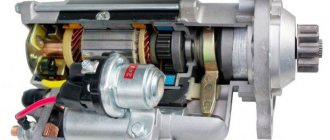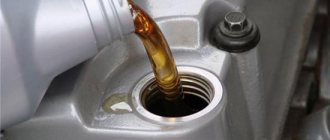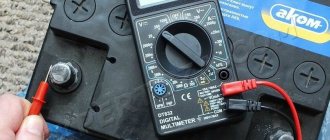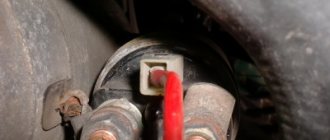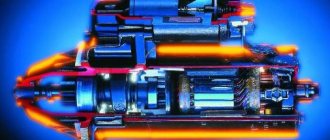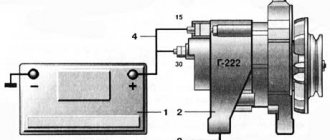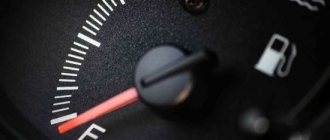Published:
18.01.2017
We take the health of our car for granted. The times when we spent as many hours under the car as in the cabin are, fortunately, gone. And when, when we turn the key in the ignition, we don’t hear the usual hum of a running engine, we become perplexed: what happened, the battery is dead, the starter takes over the current, how can we find out? If you know for sure that your battery is almost new and was fully charged, then, obviously, there is reason to blame the starter.
How does battery wear depend on storage conditions?
Finally, the cause of rapid discharge can be the driver’s simple inattention: he left energy-consuming devices turned on for an extended period:
- dimensions;
- lighting in the cabin, trunk or glove compartment;
- heated mirrors, windows, seats;
- low beam
Violation of storage conditions is also a prerequisite for the “loss” of the battery. Even a battery that is not completely discharged and stored in severe frost has its plates destroyed and its casing cracked. As a result, multiple short circuits of the plates occur. It is impossible to restore it. Therefore, you need to store the device in a warmer place (from +10 to +15 degrees).
Causes of current drawdown
As a rule, an inexperienced car enthusiast, faced with difficulties starting the engine, after some thought and attempts to use “magic” words to bring everything back to the “as it was” state, goes to the nearest car service center, where a knowledgeable specialist immediately makes a diagnosis: the starter takes over. Great! Now we know exactly what’s going on, but this doesn’t diminish the questions, and the main one is why is he behaving this way? In fact, there can be many reasons for this behavior, usually they are as follows:
- insufficient contact between the wiring and the ignition;
- insufficient resistance (may be due to a short to ground) or too high crankshaft resistance due to incorrect selection of oil or bearings;
- depletion of bushings, short circuit to the body, jamming of moving parts;
- insufficient lubrication of the gearbox.
It will be useful: Check the hydraulic compensator of the Duratec 1.6 l Ford Focus 1 engine, mileage 300 thousand km.
Even a completely serviceable starter, if any obstacle appears on the way, will perform its work with increased energy consumption. Knowledge of the mechanisms and principles of operation of the ignition system will always tell you how to understand that the starter is taking on too much, so do not neglect the theory, at least superficially.
The starter takes current: what to do in this case?
If it is possible to discover that the starter really takes on a lot of energy, first of all the motorist will need to clean all the network contacts. In some situations, stripping the battery terminals alone may be sufficient. If after cleaning the contacts the problem does not disappear, then you need to remove the starter and disassemble it. In this case, it is important to carefully inspect it for contamination of the brush assembly and other contacts. But generally in cars, the starter begins to take over the current if the following phenomena occur:
As for the latter, resistance is mainly created if the oil used by the engine is too viscous. In some cases, this can also be caused by incorrectly selected crankshaft liners, as well as improperly performed engine repairs.
More information on how to check the starter will be described in this useful video:
Source
Why does drawdown occur?
An inexperienced motorist, as a rule, when faced with a starter problem, rushes to specialists. The service station immediately makes a disappointing diagnosis - the starter is taking on excess voltage. However, no one will explain the reasons for this behavior of the starter.
So, in most cases, drawdown indicates such problems.
- The starter bushings are worn out and short to the housing, which causes the moving parts to jam (and, accordingly, the starter takes over).
- There is poor contact in the ignition system wiring.
- The resistance of the crank shaft increases or decreases, which is explained by a short to ground or incorrect selection of oil.
- If the gearbox is poorly lubricated, this can also cause subsidence.
More details about this in the table below.
Checking the starter: how to do it?
First of all, it is important to understand that a certain amount of energy is required to start the engine. It is due to this that the starter is activated. When the brightness of the lighting on the dashboard decreases significantly at the moment the engine starts, this may be the first sign that the starter is taking over the current. In addition, this can be determined through another simple manipulation. To do this, you need to listen to exactly how the starter rotates when you turn the ignition key. If the starter rotates sluggishly or even on the verge of stopping completely, this may also indicate that it is taking over the current. However, in this situation, you first need to check the condition of the car battery itself and the correct connection of the terminals to it. Basically, the engine may be difficult to start for the following reasons:
Non-original speaker systems
With rare exceptions, when tuning car audio, drivers do not think about the colossal load that acoustics place on electrical components. The energy generated by the generator is not enough, which is why the battery discharges. Therefore, when installing acoustics, it is advisable to first consult with an auto electrician, who will calculate what load is permissible for the generator.
Late battery maintenance also causes battery drain.
The battery contacts must always be carefully tightened and the terminals and surface of the battery clean. The wires should not dangle. You can clean terminals coated with oxide using sandpaper.
You need to remember one more thing - traveling short distances (especially in the city, where you often get stuck in traffic jams) also cannot have a positive effect on the condition of the battery. It simply does not have time to charge, since many generators charge the battery when the engine speed reaches 1.5 thousand.
No contact
The starter starts with difficulty, before clicking. At first you are only slightly alarmed, but the situation repeats itself again and again: first it clicks, and only then the engine turns.
Have you checked your contacts lately? You need to start with the battery, maybe you are wrong to blame the starter, and the reason is oxidation of the terminals. Have you cleaned them and the starter clicks again? You need to check how your VAZ has ground contact with the body, and then the contacts of the starter itself, because they are also prone to oxidation.
Another test method: ask someone to turn the ignition key, while you yourself knock on the relay, using only a hard object. If it starts, it means that the closing contacts (nickels) are stuck, and it is easier to change the relay than to disassemble and repair it.
Proven ways to close the starter directly: recommendations from the pros
Starter connection diagram
No less efficient and even more reliable, but you need another machine more powerful than your car. It will be enough to tow the vehicle for a short distance, and then start the engine in the same manner as described above. In this case, I would like to give a couple of practical tips:
- Do not turn off the car after it has started and then go straight to the service center;
- Do not forget that after starting the car, it will pick up speed if it is in second gear and you press the accelerator pedal;
- Don’t forget that after starting, the car towing you will stop. Therefore, you will need to have time to slow down.
Read more: How to determine engine wear: the main signs of a worn-out internal combustion engine and a quick check
Important! This method is not suitable for vehicles equipped with an automatic transmission, since due to certain features of its design, towing the vehicle is strictly contraindicated.
To implement this method, you will need a tow rope and another car. It is extremely important to strictly follow the following sequence of actions during towing:
- the leading machine should start moving smoothly and start moving at low speed to tension the cable;
- the driver of a towed car should not brake sharply;
- after the vehicle starts, it will begin to accelerate sharply;
- you should stop only after the leading car stops;
- Do not turn off the engine while unhooking the cable, otherwise it may not start, and towing will be required again.
What is the best way to close the starter - a screwdriver, a wrench or a pry bar? Let us note right away that a mount is an option for a rainy day when you don’t have a screwdriver or a key at hand. As a rule, a screwdriver and a wrench help in cases where the relay is faulty. The characteristic clicks coming from under the hood when turning the key in the ignition are full confirmation of this.
The Bendix gear is not able to turn the crankshaft because the relay does not provide enough energy. It remains to close the starter, giving voltage directly to the windings. As mentioned above, it is advisable to arm yourself with a large screwdriver or wrench that would reach both power terminals of the relay in order to bridge them.
Don’t forget to set the gearbox lever to idle and tighten the handbrake all the way. The key in the ignition switch must be turned half a turn so that the corresponding lights on the instrument panel come on. A screwdriver attached to the terminals in this case works like the relay itself. The method, as we see, is not tricky.
But you must always be on your guard. The fact is that you can damage the coil. It easily fails if you do this several times in a row. It’s just that on classic contact systems the coil does not have the appropriate protection, as on non-contact systems. To protect the coil from burning out, it is recommended to do the following:
- Ask the assistant to get into the car;
- Have him put the ignition key in the ignition position while you close the contact.
A very common problem in VAZ cars is that the car suddenly stops starting, the starter does not respond to the key. Let's try to close the starter directly. Let's fix the car on
, put the box in the “neutral” position. Open the hood and remove it for convenience
and we see the starter contacts.
The starter was closed directly, and after that, as you can see, the car started up instantly. This method will help you start your car when diagnostics and repairs are not possible. There can be many reasons for such a breakdown, we will not dwell on them, we will do a separate lesson later in which the problem will be examined in more detail. For those who don’t understand how to close the starter directly using our picture, watch the video below, it’s very simple.
After you closed the starter directly, the car started, then you turned it off again. You can try to start it again with the key, in most cases you will succeed, this is what happened with us.
Most car owners are aware of an unexpected situation when the vehicle engine does not start. Usually, the starting device is to blame, so it would be a good idea for the driver to know how to close the starter directly to start the car. Before performing the procedure, you need to learn to distinguish all the breakdowns of this unit that will require closing the starter, and become familiar with the methods for diagnosing them.
Scheme, theory and practice
Let's see what the wiring diagram of any electric starter looks like. Contact B is constantly supplied with voltage.
Starter and its external circuits
In the diagram we see three “positive” contacts and one negative (8), which is always connected to the body. What needs to be closed:
- Before closing the starter, locate the S terminal. It is often made in the form of a petal;
- How to distinguish between contacts B and M: the first will have potential “12”;
- You need to close contact B with terminal S. This is done briefly and after turning on the “neutral”;
- Contacts M and B cannot be closed.
We move from theory to practice. On a VAZ-2114 car everything looks simple.
Solenoid relay VAZ-2114
Terminal B here is covered with a rubber band, and petal S is in contact with the terminal in plastic. The plastic plug is removed before “shorting”.
Closing the starter contact with a screwdriver
Explanation of symbols:
- B – Bold, “thick” wire;
- M – Motor (electric motor);
- S – Start.
For what reasons can problems begin with the engine starting device?
Despite the fact that the starter is used for a short time, its components and mechanisms are subject to mechanical and electrical wear.
This problem can be caused by various reasons.
Among them are:
A voltage drop in the starter circuit makes itself felt when voltage is applied to the solenoid relay when the key is turned to the “st” position. It is expressed in the fact that the running lights and instrument lighting are dim. This means that the starter takes up most of the car's battery charge.
Often, the cause of this phenomenon is the connecting elements of the starter circuit. To ensure their serviceability, a complete inspection of all terminals and terminals should be carried out. Even if outwardly they look quite functional, you should not make hasty conclusions. The operating conditions of such elements involve heavy loads, which can cause them to burn, especially with weak contact.
Checking the starter armature
When the bendix barely turns or does not move at all with a fully charged battery, the issue may also be a faulty armature. Before checking the starter armature, you need to remove it from the housing. The main problems that arise with this element are breakdown of the winding to the housing, wiring of the collector terminals and interturn short circuit of the winding.
Checking the armature involves measuring the resistance between the rotor body and the windings with a tester. The indicator should be several million ohms (mOhm). If the insulation resistance shows from zero to a couple of ohms, then things are bad. It is better to replace the armature or eliminate the cause of the short circuit whenever possible.
Self-diagnosis
In order to find the cause of a mechanism malfunction, you need to understand how it works, know how the starter is connected, and how to check all its elements for serviceability.
Trigger device
The device consists of a large number of parts, but its basis is:
- electric motor;
- bendix;
- solenoid relay.
With the help of an electric motor, the energy received from the battery at start is transferred through the gear to the engine crankshaft. The starter is an electromechanical device, so it can have both mechanical and electrical faults.
It is necessary before the motorist wants to take active action. If you can identify the reasons for this behavior of the starter, then they can be eliminated right on the spot, without even going to a car service center and without wasting extra time. The basics of starter repair teach us that the most complex breakdowns are the following:
- The starter relay has failed;
- The solenoid relay has deteriorated;
- The bendix is worn out;
- The starter winding is burnt out.
What to do if the starter takes over the current?
When you find out that the starter is draining the battery too much, you must first clean all the contacts in the network; sometimes it’s enough just to clean the battery terminals.
But if this does not help, then you need to take out the starter and disassemble it; perhaps the brush assembly, solenoid relay or other contacts are clogged inside.
To summarize, in most cases, there are reasons why the starter takes over on the VAZ 2109 and other domestic cars such as the VAZ 2114 and VAZ 2106:
- the starter bushings are worn out or some parts inside the starter are jammed; there is also a short circuit between the windings, but this happens quite rarely;
- the engine crankshaft creates resistance: this usually happens if the oil used in the engine is too viscous, and in cold weather its viscosity increases even more. It is also possible that the crankshaft liners were incorrectly selected or that the engine was repaired with errors.
As a result, if you understand that the starter takes over in a GAZ 53 or GAZ 66, then you will certainly have to disassemble the starter, and this is a rather complicated procedure, so if you have no experience, then it is better to immediately contact specialists. Also, if you don’t want to tinker with the starter, diagnose it, make repairs, you can do it simpler - buy a new starter, yes it will cost a lot of money, but then the problem with starting the engine will no longer be a problem and the car will begin to bring only joy, because It will start with half a turn.
And then a quick video on how to check the starter:
problem with ZIL starter | Topic started by: Korbin
got a job at a new place. Igor (Yanira) POOR WEIGHT OF ENGINE FRAME.
Vladimir (Volker) added another wire from the engine to the frame - it didn’t help
Yakov (Jennica) did not change the batteries??
Vladimir (Volker) no. I have a new one, changed it in the spring, density 1.28
Yakov (Jennica) Vladimir, slip your starter into another zil and see how it is, don’t get into the wiring (clean the thick wires))) breakdowns to positive ground, maybe where the insulation is cracked and breakdowns through the dirt
Yakov (Jennica) on two MAZs it’s the same crap, one is 500, the other mine is newer, both have new ones (albeit strange batteries) the same story for 500 for about a month and a half and everything has been on mine for half a year and the khan doesn’t work.
Vladimir (Volker) Yakov, I already removed the starter from the worker, he had no problems. So I'll look at the wires. only it’s probably in the spring, because we’re installing them outside, and the towers won’t fit into the boxes. Thank you
Yakov (Jennica) Vladimir, good luck,
Azamat (Eachann) Vladimir, Good afternoon! I have the same problem, the starter takes over by turning the handle
Alexander (Amaron) Azamat, Yakov, Vladimir, are there other options, the same nonsense?? !
Azamat (Eachann) In general, the problem has been solved. Cleaned the contacts to ground. From the engine, gearbox. From the storter I also threw a lot onto the frame. And I turned the ignition on, it seemed to be successful) it starts with half a kick. Try)
Dauren (Adorjan) Hello everyone. Help with advice gur zila refuses to work when the engine is hot. What oil to fill
How to check whether the starter engages or not?
In order for the engine to start, the starter needs a certain amount of energy to turn it. If at the moment of starting the engine the brightness on the instrument panel decreases greatly, then this is the first sign that the starter is taking over.
Another way to find out if the starter is taking over is to listen to how the starter spins while turning the ignition key. If it spins sluggishly and feels like it will stop spinning altogether, then this could also be a sign. But first of all, you need to check the condition of the battery and how the terminals are connected to it.
How to know that “the starter is taking over the current”
We take the health of our car for granted. The times when we spent as many hours under the car as in the cabin are, fortunately, gone. And when, when we turn the key in the ignition, we don’t hear the usual hum of a running engine, we become perplexed: what happened, the battery is dead, the starter takes over the current, how can we find out? If you know for sure that your battery is almost new and was fully charged, then, obviously, there is reason to blame the starter.
Why can the starter take on a lot of current?
All possible causes of the presented malfunction, one way or another, consist of two factors:
- mechanical;
- electric.
Both are closely related. In other words, mechanical wear can lead to electrical failures. Electrical faults can cause mechanical damage.
What to do in such a situation
Unfortunately, in most cases, this problem, one way or another, can only be solved with the help of medical intervention followed by an autopsy of the “patient.” Depending on the degree of “neglect” of the problem, they resort to both preventive and surgical treatment methods.
The first method is applicable when the mechanical parts of the Bendix drive have acceptable wear, but lack lubrication. All joints should be disassembled, washed with gasoline and lubricated with graphite lubricant. The Bendix gear and overrunning clutch are also lubricated. If the starter is geared, it is advisable to lubricate the planetary gear and all other drive gears.
Note: How to find out the real mileage of a car when buying
If the brushes are “covered,” they naturally change. But, more often than not, the repairs are not limited to this. Being in a deplorable state, they probably took quite a beating on the collector. If it is black, burnt, with marks and scratches, then so be it. To get it into working condition, you can use a regular eraser, preferably a slightly worn one.
The eraser should be applied to the commutator and, evenly turning the armature, bring it to working condition. It is not recommended to use sandpaper in this case, since its abrasive material has a detrimental effect on the wear resistance of the presented units.
When the armature bushings wear out, they are replaced, unless, of course, it is too late and the armature has not crushed the seats. Sometimes it happens. For this purpose, you can use several methods. Most often, a tap of the appropriate diameter is used. By gradually screwing it into the cavity of the sleeve, it will painlessly leave its habitable place. Some car enthusiasts use a drift. It is placed over the bushing and hit with a hammer.
Such a bushing costs mere pennies, but untimely replacement can significantly hit the owner’s wallet.
Symptoms and causes of high current consumption when turning on the starter
To start the engine, the battery needs to supply a certain amount of current to the starter, the supply of which is not infinite and is consumed with each cranking of the device.
When the starter is fully operational, the battery is fully charged, and the connections of all systems are securely tightened, the car will start with a half turn. However, if there is any failure of one of the mentioned components, the starter begins to malfunction and consumes more current when starting.
If the brightness of the lights and indicators decreases when you turn the ignition key, this indicates excessive energy consumption by the starter.
The reasons for such overload may be:
- increased mechanical resistance;
- insufficient contact between electrical wiring and ignition system components;
- reduced electrical resistance.
Symptoms of a faulty starter
If the car does not start, then the problem may be in the starter.
Well, our battery is in good condition and the day before we fully charged it, how can we find out if the starter is taking over, by what signs can we determine this? The most obvious symptom: if, when turning the ignition key, the light bulbs that are powered from the on-board network lose brightness and sometimes go out, this is a sign that there is a current drawdown in the system, that is, the starter takes on excess energy. A similar situation can arise not only in the cold season, and it indicates a malfunction of the starter. However, this is only one external symptom, with the help of which we can only assume a malfunction. But where did it come from, why does this happen?
Main symptoms
Now that there is a clear understanding of what a diagnosis of “starter taking over” means, let's look at the main symptoms that indicate this problem. Let's list them, and then go through each point for greater clarity:
- difficult or unsuccessful engine starts;
- noticeable voltage drop;
- increased starting current;
- starter overheating;
- characteristic smell of burnt wiring.
The very first symptom of a starter taking over is unsuccessful or difficult starting of the engine. Its nature is already clear to us. The starter consumes electricity, but does not convert it into useful work. As a rule, this symptom is observed on both a cold and warm engine.
The voltage drop during operation of the take-over starter can be visually determined without instruments. This is clearly visible from the control lights on the panel. It should be noted, however, that with LED lamps installed in the instrument panel, a similar effect may not be observed. The voltage drop is determined more accurately and clearly using a voltmeter. It can be installed in a car, or connected separately to the battery terminals.
A normal drop during the starter is considered to be a voltage drop of up to 11.5 V. If the device shows less when starting the engine, it is possible that the starter is taking on a lot of current. Why “possibly” is explained below.
An increased starting current cannot be determined without a special device. It's called a current clamp, and it allows you to record current strength that is much greater than a standard multimeter can. The normal starting current varies from vehicle to vehicle. Therefore, in order to draw conclusions based on this criterion, you need to know how much a working starter consumes on the same machine with a similar engine. For example, to start a gasoline engine with a volume of up to two liters, the starter needs 100-120 A.
Overheating of the starter and the characteristic burning smells can be detected after several unsuccessful engine starts. A properly working starter should not have time to heat up in the few seconds during which it operates. At the same time, it shouldn’t stink either.
Detailed video on how to close the starter with a screwdriver
Thus, it is possible to start a car engine if the traction relay or the starting device winding is faulty. This method is considered the most common among motorists. In order to start the starter from the pushrod, you will need a couple of assistants who will push the car, resting their hands on the trunk. At this time, the driver engages first gear and turns the key in the ignition. The starter should start the power unit.
Note that the greater the acceleration of the car while pushing, the faster the engine starting device will begin to spin its crankshaft, and the faster the car will start.
This measure should be resorted to in the event of a malfunction of the traction relay. This is evidenced by a characteristic clicking sound in the engine compartment when turning the key in the ignition switch, when the relay is turned on, while the starter cannot give the crankshaft the required number of revolutions to ensure the engine starts due to the fact that the drive gear does not engage with the flywheel .
What does the starting current depend on?
If you look at different manufacturers, for example European countries, the USA, Russia or China, then all these batteries will have a different inrush current. So, for example, if you compare 55 Ah China and Europe, the difference can be 30 - 40%! But why is that?
It's all about technology:
- The use of purified lead, even in simple acid batteries, will lead to rapid charging and subsequent discharging, and accordingly the starting values will increase.
- A larger number of plates in a body of the same dimensions.
- More electrolyte.
- The plus plates are more porous, which will allow more charge to accumulate.
- Hermetic designs do not allow the electrolyte to evaporate, which will allow the battery to always maintain the desired level without exposing the plates.
Of course, you can add build quality and integrity of the manufacturer, all this gives better results than competitors. It’s true that such batteries are more expensive.
But at the moment, there are also new technologies - the record holders for the output of starting current are GEL and AGM batteries, their output current can reach up to 1000 Amperes in 30 seconds, about 3 - 4 times more than that of conventional acid options. Although these technologies also have their disadvantages, and first of all this is the price.
It is also worth noting that when starting the engine, the battery voltage drops to approximately 9 Volts, but the current increases many times - this is a normal process. After starting the engine, the voltage will return to its normal level of 12.7 Volts, and the spent charge will be replenished by the car’s generator. If the voltage readings during startup drop to 6 Volts (and take a very long time to recover), then this can be critical; the starter simply does not have enough energy to start. Most likely the battery is failing.
A few words about the structure and properties
Batteries were created specifically to recharge and start the car, that is, they are very practical from the point of view of operation. A regular battery discharged very quickly, and it was expensive to change it; that’s when batteries were invented.
Through trial and error, batteries evolved - so a few years after the invention, a very specific model emerged, this was about 100 years ago, which has not changed until now.
Usually these are six compartments with plates made of lead (negative) and its oxide (positive), which are filled with a special electrolyte made of sulfuric acid. It is this combination that makes the battery work; if one component is excluded, the operation will be disrupted. One scattered battery generates an average of 2.1V, this is extremely little to start the engine; in an average battery, they are combined by connecting them in series, usually 6 banks of 2.1V = 12.6 - 12.7V. This voltage is enough to excite the starter winding.
